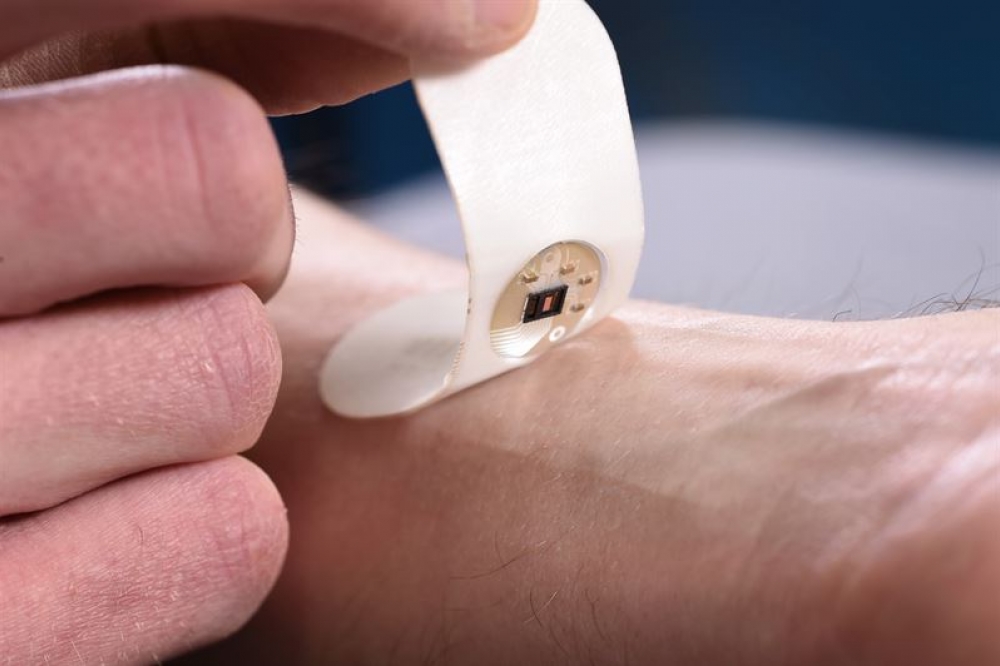VTT works to develop wearable sensors

New optical measurements are revolutionising health and wellness monitoring.
Today, more and more wearable electronics are used for monitoring health and wellness. A project coordinated by VTT is researching new measurement technologies to produce continuous, more accurate data on the wearer’s health in a cost-effective way. New measurement methods can also make treatments more comfortable for patients, allow patients to move more freely and improve patient safety.
PhotonWear is a jointly-funded two-year project launched by VTT Technical Research Centre of Finland, aiming to develop new optical methods for measuring physiological functions and biomarkers. These measurements generate data that is useful in various applications in healthcare and welfare, as they enable monitoring patients’ state of health, such as cardiac function, blood circulation and metabolism.
PhotonWear, a Co-innovation project funded by Business Finland, is part of Bittium’s Veturi program titled Seamless and Secure Connectivity. The PhotonWear project is planned to conclude at the end of October 2025. The research consortium is made up of businesses in healthcare and wellness, leading companies focused on new photonics technologies, and research institutes and academic partners. The project partners are GE HealthCare, ElFys, Oura, Bittium and the University of Oulu, with international research exchange between universities and research institutes.
Wearable sensors offer solutions to complex needs in the healthcare sector. The PhotonWear project is motivated by changes in society and demographic composition, such as the ageing of our population, which necessitates increasingly cost-effective solutions. Another perspective is that people are more and more interested in measuring their personal wellness.
“There are many situations where you need continuous patient monitoring. At the moment, hospitals measure critical parameters like oxygen saturation and ECG with health monitors that are attached to the patient, which restricts their ability to move around independently”, says Research Team Leader Teemu Alajoki, coordinator of the PhotonWear project. “Wearable, wireless sensors have many benefits: they are more comfortable to wear in hospital and at home, and you can move around freely thanks to the wireless technology. They are also non-invasive, so they don’t require taking blood samples or anything like that.”
The sensors being developed in the project are based on photonics: a field where Finland has been a forerunner for a good while now. The research in the project is especially focused on high-fidelity multispectral measurement that meets clinical requirements. One of the research targets is to measure blood pressure and lactate and glucose levels with an optical, non-invasive method.
“Nowadays, one place you find optical sensors is in smart watches measuring things like heart rate and its variability, but in this project, we’re focused on improving sensor accuracy so that they are fit for medical use, while also making them much more comfortable to wear. We are aiming for flexible or even stretchy, extremely comfortable skin-tight electronics that are unnoticeable and reliable even in demanding use cases”, Alajoki says.
Besides optical sensors, the project is also focused on advanced data analytics. Wearable sensors can collect data continuously, which makes them able to not only transmit measured health data but also send automatic warnings. For instance, if a person takes a turn for the worse after being discharged from hospital, any issues can be addressed quickly.
Partnering with robust export companies
The PhotonWear project is important for Finland because it aims to solve not only future challenges in healthcare but also current ones. The project is partnered with robust export companies, giving it potential to eventually open market opportunities for many smaller operators as well.
“GE HealthCare is a globally leading manufacturer of patient monitoring technology used in operating rooms and intensive care. Developed in Finland, the Portrait Mobile product family introduces continuous patient monitoring to hospital wards, giving patients the freedom of mobility by making it possible to go to the toilet, visit the hospital cafe or participate in post-operative, rehabilitative physiotherapy. This is enabled by wearable, wireless technology that we have developed to match the reliability of traditional, wired monitoring solutions. We aim to further develop our monitoring solutions to be even more wearable, comfortable and accurate”, says Ilkka Korhonen, research project coordinator at GE HealthCare.
The optical sensors used in the measurement devices contain a new kind of photodetector whose sensitivity is up to 50% higher compared to traditional technology. This new technology was developed by consortium partner ElFys.
“The black silicon developed by ElFys enables much more accurate measurements compared to traditional photosensors, even when measuring weak light signals. As a result, you get higher-quality data. In this project, we get to apply our technology in several applications of wearable health technology”, says ElFys Chief Technology Officer Antti Haarahiltunen.
In addition to the aforementioned aspects, the project is also exploring digital twins. Digital twins are used to create a virtual model of human tissue to model the optical properties of the tissue. The project is also developing realistic physical models based on skin and body parts, called phantoms.
The research project is a significant contribution to the development of technologies used for remote medical diagnostics, which improves cost-effectiveness in the healthcare sector and makes it possible to diagnose health issues more quickly. All combined, these technologies also promote the development of environmental eco-efficiency.
“Bittium’s contribution to the PhotonWear project is providing technological expertise for biosignal measurements outside the hospital, wireless data transmission, secure data processing, and remote diagnostics. The optical measurement methods resulting from the project can be used in Bittium’s future heart activity recording devices and analytics, as well as in the monitoring and analysis of sleep quality, sleep disordered breathing, and other sleep disorders”, says Arto Niva, Director, Medical Business and Operation at Bittium.

































